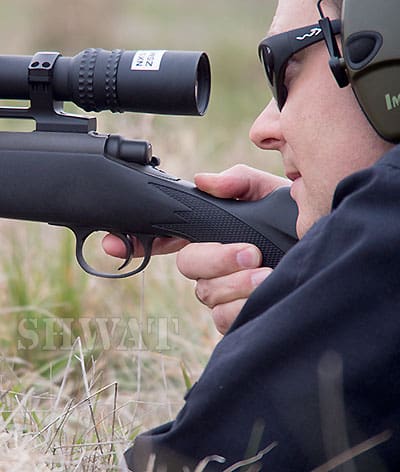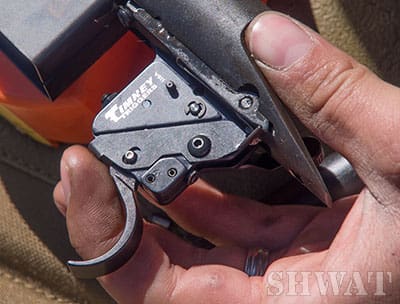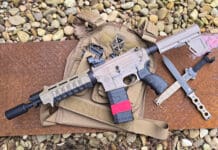This article originally appeared at SHWAT.com and is re-published here with permission.
An involuntary grin hits me as we’re filming the documentary for this Grandpa’s Gun Reborn project. No doubt the idea was cool, and the top tier companies that have signed on to be a part of turning a bland bare bones bolt action into a seriously top tier precision rifle is evidence of that. But good intentions are only so much fun.
It’s game on, now, and the excitement is getting real. In Part One of this story, I introduced you to the project. Grandpa’s .30-06 Remington 700 never really inspired. I know, it’s sad for some that a rifle with great tradition and widely regarded as a great platform failed to move me, but it is what it is. My hunting life has been all semi automatic carbines, mostly AR-15s in different calibers, different configurations. They’ve served me well for mid range and up close tactical hog hunting. For that matter, they’ve served me well for rabbits, deer, snakes… What’s not to like?
The trigger.
Like many, I did some searching around for a solution and discovered Timney Triggers. As a neophyte, I was able to drop them into my gun and those of friends. They were crisp and a dramatic improvement over the entry level stock triggers we were used to pulling. Everyone was happy.
Fast forward a few years. I’d not spent much time with the Grandpa’s gun, an ultra basic Remington 700. There was nothing about it that stood out to me, functionally or aesthetically. I could hit the gong at 200 yards, but there was nothing about the gun that inspired me to buy ammo for it. There was nothing particularly wrong with it either. It was just bland, and I’d grown accustomed to higher quality components. Then I remembered that Timney made triggers for these guns. My thoughts then jumped to optics, and then the Cadex Defense chassis I’d been introduced to on the King’s Arsenal .50 BMG XKaliber. Rapidly, the concept of turning Grandpa’s gun into a tactical long range precision gun for hog sniping sprang to life. I talked to Timney personnel at SHOT Show, and they were all over it. Timney is a natural fit for this project. They’ve been making triggers long enough that Grandpa could have used them. Founded in 1946 by World War II veteran Allen Timney, there’s a history of transforming rifles there. Timney turned old military rifles into hunting rifles. Triggers were a part of that process. Today, the Timney 510 trigger we used for the Remington 700 is second in sales only to their AR-15 trigger.
Though Allen Timney sold his business to the Vehr family in 1981, it remains a family owned shop run by the second generation of Vehrs. Their stated commitment is to produce modular triggers with a light consistent pull for accurate shots at any distance. According to Timney’s Kevin “T-Bone” Dee, the modular trigger concept answered the need to market a high quality, adjustable trigger that just about anyone could install on their own.
So why an upgraded trigger? “People work so hard to lighten the rifle and bed the stock, get the right optic,” Dee explains. “When the moment of truth comes it all boils down to putting the cross hairs on the target and squeezing that trigger. The crisper and cleaner the trigger, the easier it is to stay on target, especially at longer distances.”
I decided to start the rebuild of this gun with a trigger for a couple of reasons. First, in the Grandpa’s Gun Reborn project, we want to show what is possible for the countless numbers of people who have a neglected gun collecting dust. We want to show what’s possible to make it better, and exciting to own and shoot.
A quality drop-in trigger that is easily installed and relatively inexpensive can really put a smile on the shooter’s face. Does it make the rifle better? It does not make the rifle more mechanically accurate, but it makes it more user friendly. The crisp clean pull and break really do make staying on target and getting the hit you intended easier. The net result is improved accuracy downrange.
The Timney 510 trigger is readily available for around $130. It comes set with a three pound trigger pull, but you can contact the factory and request any weight pull between 1.5 and 4 pounds. I requested two and half pounds, and the scale says it’s right on.
Before it ships from the factory, every Timney trigger is put on an action and tested. The original Remington factory trigger used up all of our 72 ounce scale and maybe then some. The new trigger is roughly half the weight of the factory trigger, and uses a trigger block safety. And the Timney has zero creep. Yep, zero. Crisp. Exactly what I’d envisioned.
While almost anyone could install this trigger, I enlisted Jordan King, custom gun builder and president of King’s Arsenal, as technical advisor on this project. Saturday morning Jordan and I headed out to the range to film the installation of the Timney and the replacement of the gnarly old scope with a Nightforce NSX scope (more on the Nightforce in Part Three!).
Cameras rolling, in no time at all we had the Timney installed and the Nightforce mounted. Mounting the trigger essentially involves tapping the front and rear retaining pins out just far enough to remove and replace the trigger assembly, then tapping them back in. The Timney trigger is slightly wider than the stock trigger, and grooved, giving you a stronger point of contact on its surface when it’s time to shoot. Occasionally this might require opening up the channel where the trigger protrudes through the stock. In any case, it’s a very simple process with great results.
This is where it gets funny – After installing a new trigger, what would you do? You’d check for 33rd time that the chamber is empty, and you’d pull the trigger, of course. That’s what we did, followed by huge grins and congratulatory laughter at how awesome this will make the formerly boring rifle – as if it was some great accomplishment on our part to put it in. But it wasn’t, and you can easily do the same thing. In reality, the excitement was about the result, that sweet crisp click.
Now, it’s trigger time as we zero the Nightforce. I lay my Blackhawk Long Gun Pack Mat shooting mat on what’s left of some never harvested Coastal hay. Resting the now exciting rifle on a Harris bipod, I load my DRT .30-06 ammo. I sure wish Grandpa’s Gun accepted box magazines (oh wait, it will, stay tuned!).

As I begin shooting, I have flashbacks to being a kid in the Texas 4-H Shooting Sports Program. I was taught that a proper squeeze of the trigger would make the break a surprise. Carefully squeezing this trigger, I’m delighted when the break surprises me!
Jordan and I shot numerous groups on this windy west Texas day to see what kind of accuracy we could get. Winds were thirty miles per hour with gusts substantially higher. Our consistent results were 2 MOA (minutes of angle), pretty disappointing, honestly. I went out a few days later and shot it at 1 MOA, and am much happier. Once I go through the Precision Rifle class at Tac Pro Shooting Center, I know I’ll be a lot better. And once we swap out of the factory stock into the Cadex Defense Strike Dual chassis, the gun will be better.
So the question at this point is, this: Will I have time to get a wild hog with this setup before trading the old factory stock for the state of the art Cadex Defense Strike Dual chassis…?







Timney fixed my 700. Better than giving it back to Remington for a few months.
I got my Remington back in less than 4 weeks. But yes, it was sad being without for so long.
And if they stopped there this would be a really nice rifle. Heck, spend another $500 for a good stock and a smith to pillar and bed it. That would be more than good enough for 99.99999% of shooters who want to tinker with an old rifle. Guess that wouldn’t generate too many magazine sales though.
Well… stay tuned till the next sections where we go full retard to get another.25 MOA of accuracy out of this rifle… shaking my head.
Neva been done befoh!
It’s all about generating sales for the retailers. It’s the same with the hunting shows and everything else. “Well we couldn’t have done this today without the X-brand Super Awesome Magnum rifle, $-brand Mega Cash Super Zoom Optics, our Ultra Cost More than Your Car ATV, and the fine folks at You Can’t Afford Us Ranch.” I understand the they have to get paid too and sponsorship is most of it, but damn at the commercialization.
To all you whiners out there, I see this more as an educational series than a practical thing to do and I think that’s how its intended.
Sure, James – we really do “get” it, and I don’t think anyone’s really casting aspersions on SHWAT personally. But dropping expensive doodads on a firearm isn’t really gunsmithing. There are a ton of things that can be done that don’t cost all that much that will have just as big an impact on accuracy and ergonomics as dropping an ancient M700 into a $2500 modular chassis (which is a joke in and of itself).
I did a project a few years ago to test my amateur gunsmithing skillz. I’d been buying parts and pieces for a couple of years before finally acquiring a little Shoptask 3-in-1 mill/drill/lathe for my shop (cost, about $3K, or about the same price as a fancy-assed “modular chassis.”) My goal was to build a 1/2 MOA rifle that would compete with my buddy’s custom target rifles at ranges out to 800 yards at the annual Boomershoot event in Idaho – for under $600.
That $600 bought me a beat up VZ-24 Mauser action; a new, surplus Parker-Hale target barrel, bolt, and trigger group from SARCO; an inletted, unfinished laminated target stock from Richards Microfit. Purchased over a period of a couple years, this didn’t even make a blip in my budget.
Then, with the Shoptask I was able to build the tooling myself to true the action, fit the barrel, lap the locking lugs, recrown the barrel, and turn and install bedding pillars. The stock was semi-inletted, so easy to finish up the bedding and glass bed it. Finishing the stock was fun – had to do some tweaking on a Mauser scope mount so I could get a 20MOA slope built into it. I even cobbled together a Harbor Freight sandblaster and a water tank so I could parkerize the rifle myself – it turned out great! The optics weren’t included in my budget.
When I got done I had a great target rifle in .308. Was it perfect? No, by any means – the Mauser action for an 8MM is longer than needed for a short-action .308. Mausers aren’t exactly a gunsmith’s first choice for precison rifles anyway – but the price was right for my el cheapo build. And it was dead accurate when completed – I ended up selling it for about $1200.
The point to this was that even kitchen-table gunsmiths can get far more intimately involved in the actual buildup of a rifle or pistol than by simply clicking options on the Brownell’s web page. That’s a start, but when you actually learn how to do some of this stuff, the building is just as much fun (or more so) than the shooting. Making Grandpa’s shooter into a tack driver using the original parts would be a far more fun and challenging task than simply keeping the action and chucking everything else.
What happened to actually gunsmithing, these are all just simple spend your money plug and play parts. Its really not that hard to break the trigger assembly down and take a honing stone to the mating surfaces and get just as good a trigger for $0, just a few hours of your time. I can already hear the “well that can be unsafe and dangerous” replies, you have to be patient and precise yes but you shouldn’t be working on firearms anyway if you don’t have that anyway.
The death of shop class in high school is what happened. Film was at 11 this morning.
Kids might get hurt using that machinery! I’m not going to let my precious snowflake around that dangerous stuff!
Just ordered a Timney myself. I had one of those so called collector grade Mitchell’s mausers that I wanted to convert to .308. It was a Yugoslavian M48. Had my gunsmith get me a match grade 308 barrel and install it while keeping all the orginal furniture and sights intact. He reinstalled the orginal front hood sight and reblued everything to match. Don’t know why but I never thought about a trigger job till after I got it back so a drop in Timney was the way to go.
I have tried their 98k trigger and their Mosin trigger. I have dryfired their AR trigger.
All were excellent but expensive.
I now own the Mosin trigger. It cost 3 times the monetary value of the rifle it went into 🙂 but I can hit clays at 200 meters with ease.
Timney triggers aren’t that expensive. Really.
There are two-stage match triggers out there that go for $350+, and double set triggers out of Germany for sporting rifles that can cost at least as much.
What the hell is “tactical” hog hunting?
It’s where you hunt hogs operationally, dressed as an operator.
I figured it might have something to do with clothes.
Same as normal peon hog hunting but costs 10x as much
Comments are closed.